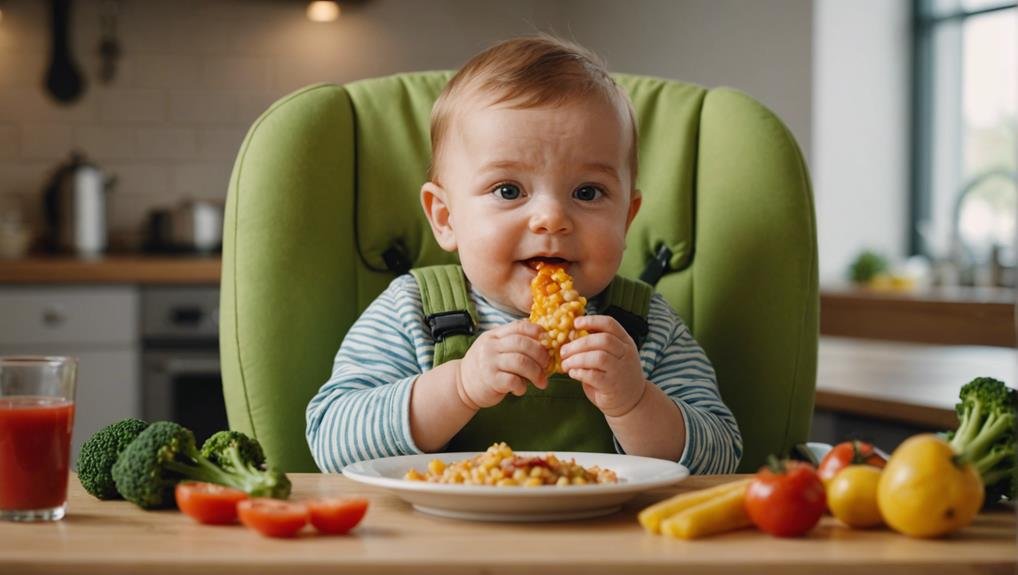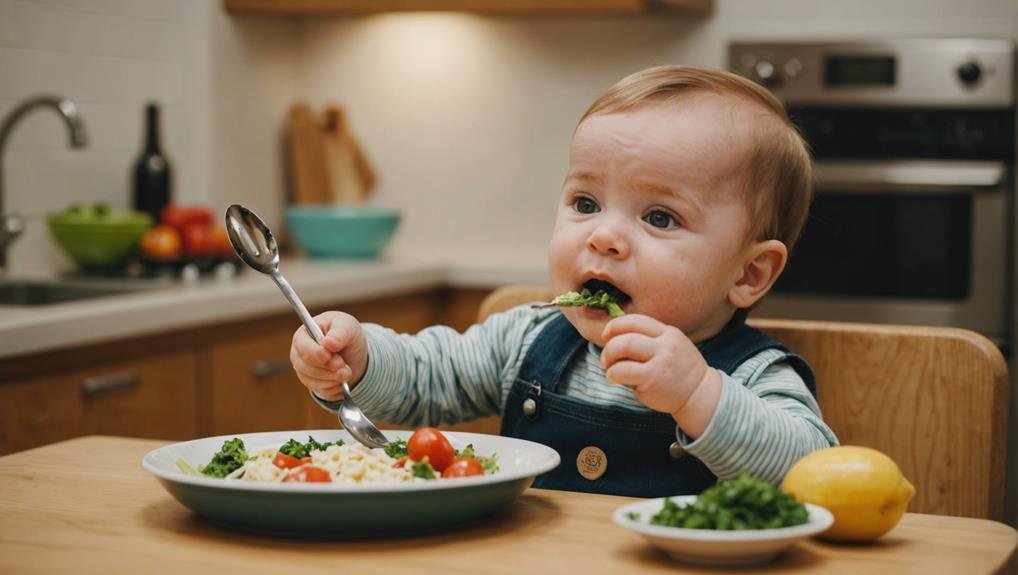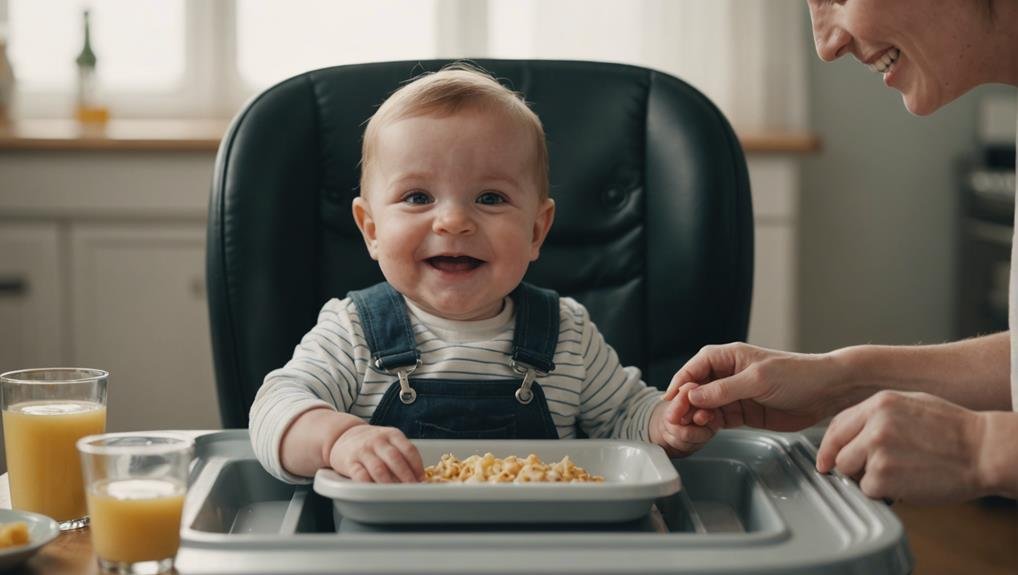"Cherishing Little Steps - A Haven for Baby and Family Journeys"
Baby Led Weaning
When considering introducing solid foods to your baby, have you ever thought about trying Baby Led Weaning? This method, gaining popularity for its unique approach to starting solids, puts the power in your little one's hands. Imagine the independence and exploration it could bring to your baby's mealtime experience. How does it work, and what are the potential benefits? Let's explore the ins and outs of Baby Led Weaning together.
What Is Baby Led Weaning?

Baby Led Weaning is a method of introducing solid foods to infants that allows them to feed themselves from the start, skipping purees and progressing directly to whole foods. This approach emphasizes parental involvement and encourages the exploration of various textures, tastes, and shapes, promoting self-feeding skills. By involving parents in the feeding process, Baby Led Weaning nurtures a positive feeding relationship between the caregiver and the child, fostering trust and communication during meal times.
One of the key benefits of Baby Led Weaning is the focus on developmental milestones. Infants have the opportunity to practice their motor skills and hand-eye coordination by grasping and manipulating foods independently. This method supports the natural progression of oral motor skills and encourages chewing, which is essential for proper swallowing and digestion.
Additionally, Baby Led Weaning offers nutritional benefits as infants are exposed to a wide range of nutritious whole foods from the beginning of their solid food journey, potentially setting the stage for healthy eating habits later in life. By promoting self-feeding skills and involving parents in the process, Baby Led Weaning lays a strong foundation for a positive feeding experience.
Benefits of BLW
Embracing Baby Led Weaning presents numerous advantages for both infants and caregivers alike. When it comes to developmental benefits, BLW encourages infants to explore different textures, tastes, and shapes of food, promoting oral motor skills and hand-eye coordination. Additionally, the practice enhances parental involvement during mealtimes, fostering a positive relationship with food from an early age.
Nutritional advantages of BLW are significant, as it allows infants to self-regulate their food intake based on hunger cues, promoting a healthy relationship with food and potentially reducing the risk of obesity later in life. By offering a variety of nutrient-dense foods in their whole form, infants can learn to appreciate the natural flavors and nutrients present in unprocessed foods.
Furthermore, the self-feeding aspect of BLW encourages independence and fine motor skill development in infants, empowering them to take control of their eating experiences.
Is Baby Led Weaning Safe?

Ensuring the safety of Baby Led Weaning is paramount for successful implementation and positive outcomes for both infants and caregivers. Parental concerns about choking risks often arise when considering BLW. Research findings suggest that while gagging is common during the introduction of solid foods, it's a natural reflex that helps prevent choking.
It's crucial for parents to stay informed and educated about the differences between gagging and choking to feel more confident during this process.
Safety precautions play a vital role in the success of Baby Led Weaning. Parents should ensure that infants are developmentally ready for BLW, sitting unassisted and showing interest in food. It's also recommended to introduce one new food at a time to monitor for any allergies or intolerances.
Seeking pediatrician approval before starting BLW can provide additional reassurance and guidance tailored to your child's specific needs.
Best First Foods for BLW
Selecting appropriate first foods for Baby Led Weaning is crucial for a smooth transition to solid foods and optimal nutrition for your infant. When embarking on this journey, offering nutrient-dense options is key. Here are some excellent choices to kickstart your baby's BLW experience:
| Avocado Slices | Steamed Carrots | Scrambled Eggs |
|---|---|---|
| Banana Chunks | Sweet Potato Fries | Soft Cooked Broccoli |
Avocado slices are rich in healthy fats, making them a great choice for brain development. Soft-cooked carrots provide a sweet taste and are packed with beta-carotene for eye health. Scrambled eggs are a fantastic source of protein and essential vitamins.
Banana chunks are easy to grasp and gentle on the stomach. Sweet potato fries offer a soft texture and are loaded with vitamins and fiber. Lastly, soft-cooked broccoli introduces your little one to greens and is full of essential nutrients. Remember to supervise your baby closely during mealtimes and enjoy this exciting BLW journey together!
BLW Vs. Traditional Weaning

When comparing Baby Led Weaning (BLW) to Traditional Weaning, it's important to understand the distinct approaches and potential benefits each method offers for introducing solid foods to your infant.
BLW involves allowing your baby to self-feed from the start, promoting independence and fine motor skills. In contrast, Traditional Weaning typically involves spoon-feeding purees to your baby.
One of the key benefits of BLW is that it encourages babies to explore different textures and tastes, potentially leading to a more varied diet later on. Additionally, BLW promotes self-regulation of food intake, which may help prevent overeating in the long run.
When it comes to safety, some concerns with BLW include the risk of choking due to the introduction of solid foods early on. However, following safety guidelines such as offering appropriate-sized foods and supervising meals can help mitigate these risks.
Traditional Weaning, on the other hand, may involve a slower transition to solid foods but can provide more control over what your baby eats.
Ultimately, both methods have their own benefits and safety considerations, so it's important to choose the approach that aligns best with your parenting style and your baby's needs.
Tips for Success With BLW
To maximize success with Baby Led Weaning, prioritize offering a variety of nutritious finger foods in appropriate sizes to encourage exploration and self-feeding skills in your baby.
Mealtime independence is a crucial aspect of BLW, allowing your little one to develop a healthy relationship with food from an early age. Remember, it's normal for parents to experience some parental anxiety during this process, but trust in your baby's innate ability to self-regulate their food intake.
As you embark on this journey, keep in mind that BLW isn't just about nutrition but also about fostering independence and fine motor skills. Introduce a mix of textures, flavors, and colors to make mealtime engaging and enjoyable.
Be patient and allow your baby to explore at their own pace, even if it gets messy – it's all part of the learning process.
Baby Led Weaning Gear

Consider essential gear that can facilitate your baby's exploration and self-feeding journey in Baby Led Weaning. When it comes to high chair options, look for sturdy models with adjustable trays to bring your little one to the table comfortably.
Utensil choices are crucial; opt for easy-to-grasp, baby-friendly utensils that encourage self-feeding skills.
Bib recommendations play a vital role in keeping your baby clean during meals. Look for waterproof, easy-to-clean bibs that catch food crumbs and spills effectively.
Suction plates are a game-changer, preventing your baby from accidentally tipping over their food and promoting independent eating skills.
Investing in the right gear can make your Baby Led Weaning journey smoother and more enjoyable for both you and your little one. Choose high-quality items that prioritize safety and convenience to create a positive and engaging mealtime experience.
Managing Mealtime Mess
Utilize practical strategies to effectively manage mealtime mess while introducing your baby to the Baby Led Weaning approach. When embarking on this journey, consider high chair alternatives such as booster seats or suction plates to minimize food flinging. Cleaning hacks like using splash mats or placing a large bib on your little one can help contain the mess. By minimizing food waste through appropriate portion sizes and offering a variety of foods, you can reduce the aftermath to clean up. Engage in sensory play benefits by allowing your baby to explore different textures and tastes during mealtime, fostering their development while embracing the mess.
—
| High Chair Alternatives | Cleaning Hacks |
|---|---|
| Booster seats | Splash mats |
| Suction plates | Large bibs |
—
Signs of Readiness for BLW

Observing your baby for specific signs of readiness is key before starting Baby Led Weaning (BLW). Look for important developmental milestones like sitting up unassisted and showing an interest in reaching for and exploring food. These are positive indicators that your little one may be ready to begin their BLW journey.
It's normal for parents to have concerns about starting solids in this way, but with guidance from your pediatrician, you can navigate this new phase confidently.
Before diving into BLW, ensure your pediatrician approves of this feeding method. They can provide valuable advice tailored to your baby's specific needs and health status. Additionally, be aware of potential food allergy risks and introduce one new food at a time, waiting a few days before offering another.
Troubleshooting Common BLW Challenges
Addressing common challenges that arise during Baby Led Weaning (BLW) can help parents navigate this feeding method with confidence.
Two significant challenges that parents often encounter during BLW are dealing with picky eaters and managing concerns related to food allergies and choking hazards.
When faced with a picky eater during BLW, remember that it's normal for babies to have preferences. Encourage exploration by offering a variety of foods and textures. Introducing textures gradually can also help your baby become more comfortable with different types of foods.
Food allergies and choking hazards are valid concerns for parents practicing BLW. To address these challenges, always supervise meal times closely and familiarize yourself with common choking hazards. Introduce allergenic foods one at a time and observe your baby for any signs of an allergic reaction.
Frequently Asked Questions
Can Babies Choke During Baby Led Weaning?
You must always be cautious about choking hazards with babies. Safety is paramount. Ensure proper supervision and learn techniques to prevent choking incidents. Your vigilance and preparedness are key to keeping your baby safe.
How Do I Prevent My Baby From Becoming a Picky Eater?
When it comes to preventing picky eating in your little one, mealtime strategies and consistent food exposure are key. Offer a variety of nutritious foods regularly, involve them in meal prep, and make mealtimes positive experiences.
Are There Specific Foods to Avoid During Blw?
When introducing solid foods, be mindful of allergenic foods and safety concerns. Ensure proper nutrition for your baby through texture exploration. Variety is key. Stay informed, trust your instincts, and enjoy this new feeding journey together.
Should I Still Offer Purees Alongside Blw?
Yes, offer purees alongside finger foods during texture progression. This approach supports development by providing various textures for exploration. Remember, babies learn through touch and taste, so combining purees with finger foods can enhance their feeding experience.
How Can I Ensure My Baby Is Getting Enough Nutrients?
Imagine your baby's diet as a vibrant garden. Ensure it blooms by offering a rainbow of nutrient-dense foods in appropriate portion sizes. Embrace food variety and thoughtful meal planning to nourish their growth.
Conclusion
In conclusion, Baby Led Weaning can be likened to planting seeds of independence and healthy eating habits in your little one's garden of growth. By allowing them to explore and experience a variety of nutritious foods from an early age, you're nurturing their development and fostering a positive relationship with food.
Embrace the mess, celebrate the milestones, and enjoy the journey of watching your baby blossom into a confident, competent eater. Happy feeding!




